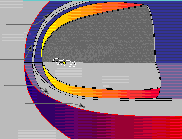 |
Click on image for larger version. |
|
The solar wind streams off of the Sun in all directions at speeds of several hundred
km/s (about 1,000,000 mph in the Earth's vicinity). At some distance from the Sun, well
beyond the orbit of Pluto, this supersonic wind must slow down to meet the gases in the
interstellar medium. It must first pass through a shock, the termination shock, to become
subsonic. It then slows down and gets turned in the direction of the ambient flow of the
interstellar medium to form a comet-like tail behind the Sun. This subsonic flow region is
called the helio-sheath. The outer surface of the helio-sheath, where the heliosphere
meets the interstellar medium, is called the heliopause.
|
|
The precise distance to, and shape of, the heliopause is still
uncertain. Interplanetary spacecraft such as Pioneer 10 and 11 and Voyager 1
and 2 are traveling outward through the solar system and will eventually
pass through the heliopause.
The solar wind consists of particles, ionized atoms from the solar corona, and fields,
in particular magnetic fields. As the Sun rotates once in about 27 days, the magnetic
field transported by the solar wind gets wrapped into a spiral. Variations in the Sun's
magnetic field are carried outward by the solar wind and can produce magnetic storms in
the Earth's own magnetosphere.
|

